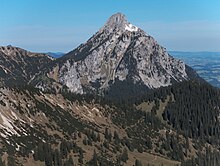Two-thousanders
As Zweitausender (also written shortly as: 2000 ) are mountains referred to a height of at least 2000 meters, but less than 3000 meters above sea level have.
Occurrence in Central Europe
Low mountain ranges are defined (for Central Europe) up to about 1500 to 1800 m, so that they are usually not available there. In the foothills of the high mountains in Europe, significant 2000s mostly have the character of rocky, geographically dominant mountains. In the high mountains themselves, they may only form ridges and ridges, they can only emerge as hills when plateaus are below the 2000 mark.
Climatic aspects
Climatically, the difference to low mountain ranges is striking, provided that the 2000er has a wind-exposed location. The temperatures are mostly in the same range, while at three thousand meter peaks in the temperate latitudes the zero degree limit can be undershot even in midsummer.
Bio and settlement geographical aspects
From a biogeographical point of view, Central Europe’s 2000s are already in the middle of the alpine level (or equivalents in other parts of the world), and consistently above the tree line , in terms of settlement geography in the temperate latitudes in the anecumene : here no permanent settlement and agriculture is possible (the highest permanent settlements in the Alpine region lie up to approx. 2100 meters), but still in the middle of the alpine region (up to approx. 2500 m lawn and mats, above them subnival cushion plants). In the Mediterranean area there is already the arid thorn cushion step (starts in Crete at 1500, in the Atlas at 2400 m), the two-thousand-meter peaks are largely desert-bare in appearance. In the Andes, for example, the level above 2000 m (up to 3500 m) is called Tierra Fria (“cool land”) in the tropical part , here the 2000s, which primarily form the coastal and Amazonian foggy upstream chains, lie completely below the tree line (foggy clouds in East: Yunga , to the west Lomas ). In the Hindu Kush they form the typical coniferous forest level as foothills and valley framing .
Alpinism and sporting aspects
From an alpine point of view, the 2000s are generally regarded as easy to moderately demanding tours in the low and foothills, but then mostly as attractive mountains with views. The thinning mountain air begins to play a role in the 2000s, at an altitude of 2500 meters the air pressure is only 560 mmHg / 750 mbar (compared to approx. 760 mmHg / 1013 mbar at sea level, i.e. about ¾; barometric altitude formula ). This represents a significant burden for mountain visitors who are not used to the altitude; on the other hand, the positive effect on metabolism has already been proven at these altitudes: at an altitude of 2500 m, the increase in breathing ventilation at the beginning of the acclimatization phase is 65%, the body processes become normal increased three to seven times. Therefore, tours in the 2000s (assuming that overloading is avoided, of course) are beneficial to your health, and this altitude - of course not only related to mountain peaks - is also recommended for hypoxia training (altitude training). A direct ascent with aids (cable car, car) is generally not an abnormal burden for a healthy body, acute mountain sickness (AMS) normally only occurs from the 3000 m mark, only minor problems from 2500 m.
Individual evidence
- ↑ Heinz Ellenberg : Vegetation of Central Europe with the Alps in an ecological, dynamic and historical perspective. 5th, heavily changed and improved edition. Ulmer, Stuttgart 1996, ISBN 3-8001-2696-6 .
- ↑ Herbert Reisigl: Vegetation landscapes and flora of the Mediterranean area . In: Robert Hofrichter (Ed.): The Mediterranean. Fauna, flora, ecology . Series The Mediterranean . Volume I: General Part . Spektrum Akademischer Verlag, 2001, ISBN 978-3-8274-1050-4 , 4th, pp. 169-207 .
- ↑ after W. Zech, G. Hintermaier-Erhard: Soils of the world - A picture atlas . Heidelberg 2002, p. 98 .
- ↑ Siegmar-W. Breckle: flora, vegetation and ecology of the alpine-nival level of the Hindu Kush (Afghanistan) . In: S.-W. Breckle, Birgit Schweizer, A. Fangmeier (Ed.): Results of worldwide ecological studies. Proceedings of the 2nd Symposium of the AFW Schimper Foundation . Verlag Günter Heimbach, Stuttgart 2004, ISBN 3-9805730-2-8 , Ecology Tab. 3, p. 112 (97-117) .
- ^ Karl Hammerschmid: Altitude training - hypoxia training . Ed .: radsportverband.at. What is different in height?, P. 4 .
- ↑ Hammerschmid: Altitude training . What is altitude training ?, p. 2 .
- ↑ see Hartmut Bielefeldt: Altitude adjustment - acclimatization and adaptation. Adaptation section . In: Hartmut's Homepage - Mountains. Retrieved on August 18, 2011 (primarily for high-altitude mountaineering; with links to specialist websites).
- ↑ Altitude sickness, mountain & expedition medicine. In: TrekkingGuide.de. Retrieved August 18, 2011 .

